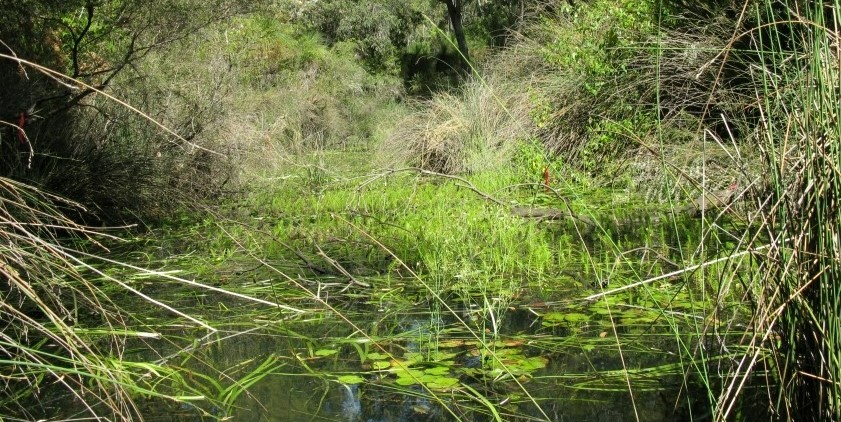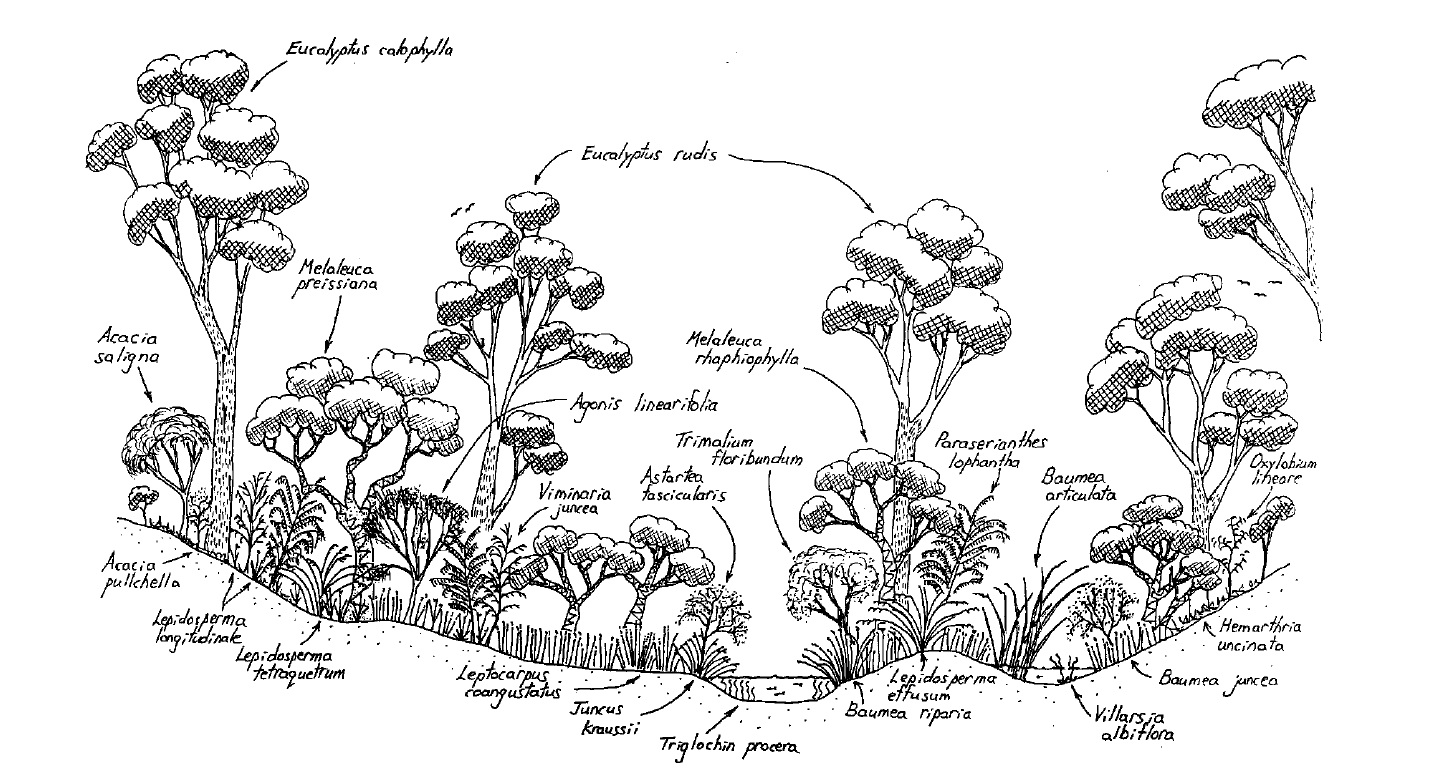Aquatic and riparian vegetation contribute to the balance of oxygen, nutrients and sediment, and provide habitat and food for fauna.
Aquatic plants and algae grow within the waterway channel. Some are completely free floating (e.g. filamentous green algae) but most have roots or root-like structures in the sediment and can have floating leaves (e.g. water lilies), structures emerging from the water (known as emergent plants e.g. water ribbons) or be completely under water. These are known as submerged plants and include seagrasses in estuaries.
Riparian vegetation (also known as fringing vegetation) grows along the banks of a waterway, extending to the outer edge of the floodplain. It includes the emergent aquatic plants growing at the edge of the waterway channel and the ground cover plants, shrubs and trees within the riparian zone.
Riparian vegetation often shows zonation in the plant species present as the environment changes from permanently to seasonally to intermittently inundated habitat within the floodplain of the river.
A typical cross section of native plant species of the lower south-west of Western Australia is shown in the diagram below.
Source: Revegetating riparian zones in south-west Western Australia, River restoration manual
Read more about aquatic and riparian vegetation below.
Role of aquatic plants, algae and riparian vegetation
Show moreAquatic plants, algae and riparian vegetation play an important role in keeping waterways healthy by:
- absorbing nutrients from water flowing into a waterway (both over the land surface and through groundwater) and from within the waterway itself
- slowing the water flowing over the land surface into a waterway – this allows sediment and pollutants in the overland flow to deposit in the fringing zone, reducing sedimentation and pollution of the waterway
- stabilising the banks and bed of a waterway – plant roots bind the sediments to reduce erosion
- oxygenating a waterway – oxygen is a by-product of photosynthesis, the process by which plants and algae make sugars from carbon dioxide and water using sunlight
- providing elements for the food web such as carbon, nitrogen and phosphorus
- providing habitat for aquatic and terrestrial fauna, including essential migration corridors between waterways. Fauna include fish and crayfish, macroinvertebrates, turtles, frogs, lesser known riparian specialists such as rakali (water rats) and some species of birds
- shading a waterway – this helps to control water temperature and reduce the growth of phytoplankton which helps prevent algal blooms
- providing a physical barrier to prevent access by stock – which can lead to erosion and nutrient inputs and to prevent the spread of weeds via the waterway.
Value of riparian vegetation
Show moreThe value of riparian vegetation and its role in maintaining the physical condition and ecological health of waterways is well known.
The historic removal or degradation of riparian vegetation through activities such as land clearing for agriculture, grazing, mining and weed invasion has resulted in the degradation of many waterways.
Waterway health can be improved by protecting and restoring riparian vegetation. A foreshore area or foreshore reserve helps to protect aquatic and riparian vegetation and other waterway values from many of the potential impacts of land use and development.
Read more about the values of the riparian zone.
Our monitoring and assessment programs
Show moreThrough our Healthy Rivers program, we assess and monitor the condition of aquatic and riparian vegetation for waterways across south-west WA, using specific methods to assess the fringing zone.
Seagrass and macroalgae are monitored in selected south-west estuaries as part of the Healthy Estuaries WA program.
Aquatic and riparian vegetation are amongst the values we consider when assessing impacts of proposed land use change and development on waterways, water resources and the environment.
This includes when we:
- develop water allocation plans
- assess applications for clearing native vegetation
- provide advice about waterways foreshore areas, urban waterways management and living streams when we consider waterways in planning and development.
Publications
Show moreThe following publications provide information and guidance about aquatic and riparian plants in Western Australia:
- Native vegetation of freshwater rivers and creeks in south Western Australia
- Native vegetation of estuaries and saline waterways in south Western Australia
- Riparian plants of the Avon catchment
- Aquatic plants in the Canning River (River Science 19)
- Macrophytes and macroalgae in the Swan Canning estuary (River Science 20)
- Water note 10 - Protecting riparian vegetation
- Water note 11 - Identifying the riparian zone
- Water note 12 - The values of the riparian zone
- Water note 15 - Weeds in waterways
- Water note 29 - Long-term management of riparian vegetation
- Revegetating riparian zones in south-west Western Australia, River restoration manual
- Other chapters of the River restoration manual.
Examples of the management of aquatic and riparian vegetation can be found in the River action and recovery plans and Water quality improvement plans for Western Australia.
The presence and condition of aquatic and riparian vegetation are important indicators of the health of a waterway. They form part of the criteria for assessing waterways in the Foreshore condition and assessment and the South West Index of River Condition.




